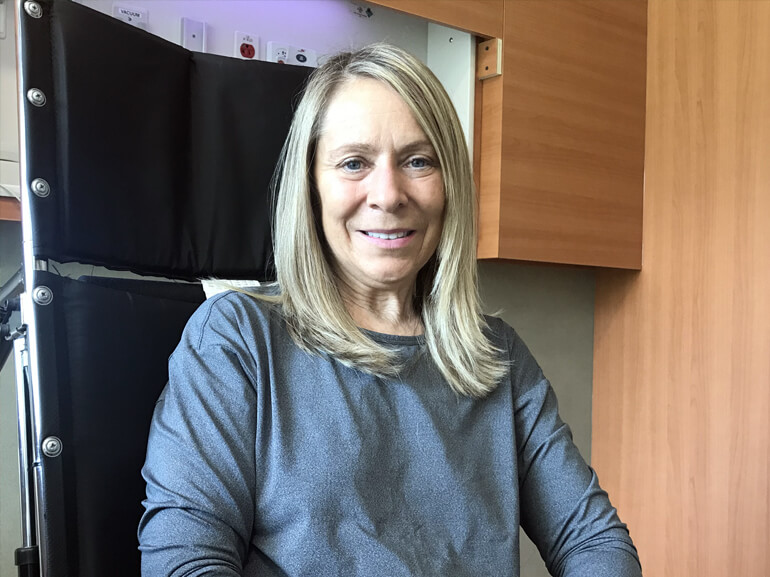Judy's story

Life changed suddenly for 55-year-old Judy Polverini when extreme dizziness led to a fall resulting in multiple fractures and a spinal cord injury. The fall left Judy unable to move below the neck. Married with five adult children, Judy was accustomed to a busy life as a caregiver for an older sister and childcare support for her five grandchildren, ages four months to eight years old. After spinal surgery and twelve days in the hospital, Judy remained paralyzed from the neck down, only able to move her left thumb.
The medical team stabilized Judy and recommended a stay in a medical rehabilitation hospital for further rehabilitation and recovery. For that, she and her family chose Penn State Health Rehabilitation Hospital.
Upon arrival, Judy needed four care team members to help her stand and move to into a wheelchair – she was unable to move her arms and legs. After Judy’s care team assessed her, they developed a customized treatment plan to meet her key goal -- to regain her independence.
Physical therapy immediately went to work with Judy, using a range of equipment to increase her mobility. Initial therapy focused on building movement patterns and neuromuscular re-education -- balance training to help her regain normal, controlled movement -- with the use of parallel bars and a specialized walker with forearm support. She also spent time on the Functional Electrical Stimulation (FES) bike which fed low level electrical impulses to Judy’s nerves, reacquainted her leg muscles with active cycling patterns and increasing blood flow to her muscles. She also trialed multiple types of ultralight specialty wheelchairs to determine the best fit for her body and lifestyle.
As Judy’s endurance increased, she progressed to the exoskeleton, a wearable robotic device that helps retrain muscles to walk and reacquaints the patient with proper gait mechanics. Judy’s therapists described how the device would feel and its benefits which allowed her to be comfortable using it. They explained that it would help her rise to stand and assist in walking. It provided full walking assistance at first which was dialed back as her legs gained strength. “The technology and equipment here is amazing,” Judy said.
Occupational therapy (OT) also put Judy to work. When she admitted, she required total assistance for self-care -- bathing, dressing and toileting. Judy had little to no movement in her hands and intense pain throughout her upper extremities. OT started by focusing on building full body endurance and fine motor coordination. Judy did standing balance exercises while engaging in sorting activities that improved her hand and finger movements. Slowly, Judy progressed and began dressing and bathing herself. On top of that, with practice, she regained the ability to write.
Recreational therapy also played a role in Judy’s recovery. Since Judy’s family enjoys competitive board games, her therapist honed her fine motor skills by playing new games with her. An active gardener, Judy was anxious to regain her range of motion and mobility in order to start planting again. On weekends in the hospital, she enjoyed spending time outdoors in the courtyard and gardens where she could visit with her grandchildren and play games on the patio.
After three and half weeks of inpatient rehabilitation, Judy could independently manage her wheelchair, was able to walk with a rolling walker with grip assistance and could independently manage her self-care needs. She was ready for discharge and looked forward to returning home and continuing her recovery as an outpatient in the neuro-recovery program.
Regarding her hospital stay, Judy said, “I’m just so blown away. If there weren’t facilities like this, I would have gone home with my family having to do everything for me… I went from ‘dying’ to ‘paralyzed’ to ‘walking,’ and I’m sure that would not be the case if I had been sent home without coming here first.”